It took more than a decade, but after multiple summers of returning from vacation to find my mostly native plant landscape chafed and my vegetable garden burnt to a crisp, I’m been taking a hard look at drip irrigation.
This proud hose dragger is not the only one. According to industry reports, the global drip irrigation market topped $9.4 billion in 2022 and is headed toward $23 billion by 2028 for 13.9% growth rate, according to a July 18 press release issued by Insight Partners, an industry research company that focuses on technology and science.
That’s good news. Automated and aerial sprinklers and even hose dragging (a.k.a. manual watering) are all less efficient than a well designed drip system. That’s because a plant’s roots utilize water to encourage growth. When you spray water on the leaves or above ground–especially during hot weather–much of it evaporates. Drip systems are typically buried or lay on top of the soil, slowly dripping water onto the ground, creating a more efficient method of H20 delivery.
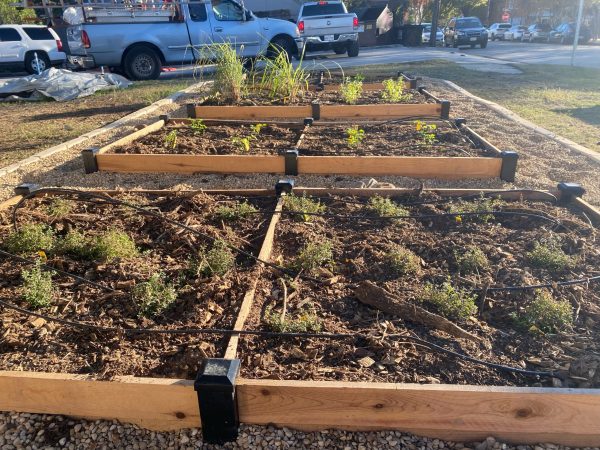
Mitch Hagney oversees drip irrigation at multiple gardens and farms in San Antonio. This one, outside Little Death wine bar near downtown, grows herbs. Photo courtesy Mitch Hagney
With the entire country experiencing the hottest summer in recorded history, drip irrigation makes huge sense. Professional farmers are on board. But for home gardeners, it’s not a simple decision.
Experts I spoke with could not stress enough the high maintenance and often wasteful nature of drip irrigation, especially in situations with hard water like ours in San Antonio.
“Drip always has the same problems, it’s high maintenance,” said Brad Wier, a conservation specialist at SAWS, San Antonio Water System. Wier and other staff at the Alamo City’s public water utility have written extensively about the perils and pitfalls of drip irrigation on their conservation landscaping website, GardenStyleSA. General conclusions: most problems result from bad design, user error and lack of maintenance.
The biggest mistakes people make are poor design and overscheduling. Faulty design can include overlapping, tangled drip tubes and lines spaced too close together as well as lines arranged in nonsensical geometric patterns in places void of plants. Leaks and overzealous watering frequently go undetected because drip lines are often buried in mulch or hidden under plant growth. Couple that with the calcium/lime build-up associated with the hard water we enjoy in San Antonio and regular inspections/system flushes will be mandatory to keep things running smoothly.
Photos and captions courtesy of SAWS
Also consider the hidden challenges of drip irrigation. “Squirrels chew on it. After about six months, it starts to leak. People hit it with tools,” said Wier. He cautions that drip is meant to provide “a week or two worth of water” to plants, soaking the soil so the water reaches the roots. “There’s never a reason to run it every day,” he said. Drip systems tend to run longer than other types of irrigation–sometimes 45-60-minutes at a time.
While my yard is mostly native plants, I have two areas devoted to vegetables–usually tomatoes and okra. This year, with the extreme heat, these vegetable patches have not fared well. Even the heirloom hybrid Green Zebra Tomato seeds I ordered because of their reputation for flourishing in hot weather suffered seriously without regular watering. Thus, I took a look at drip irrigation for this patch of my yard.
Family friend Mitch Hagney, director of food sustainability at the San Antonio Food Bank, offered to provide an introduction and tutorial. Hagney oversees farming initiatives for the Food Bank, growing food around San Antonio and distributing it to the community. He’s a big fan of drip irrigation for large scale food production. “It’s the only efficient way to reliably produce crops in South Texas,” he said, adding that alternatives like flooding, rotation pivots, and sprinklers cost far more water and deliver it to more weeds than crops. “There’s good reasons for the majority of regional farmers to use drip lines for cultivation.”
Hagney came by to share his drip irrigation knowledge and schooled me on how to install it for a 10- x 4-foot full sun tomato plot. Cost for parts totaled less than $100 and Hagney provided free labor and instruction. We were done in 30 minutes.
All good, so I tried to install a drip system on my other vegetable patch, but it did not go so well. The water pressure from the house to the hose was too much and no matter how many adjustments, pressurizers and attachments placed on the adapter, water spewed everywhere. This raised concerns about what this might do to my foundation, given that the water oozing from this spigot would inevitably dribble down under the house. That might be a good thing if water were applied unilaterally around my foundation, but in this case it would be an isolated damp zone and possibly shift the slab foundation. No thank you.
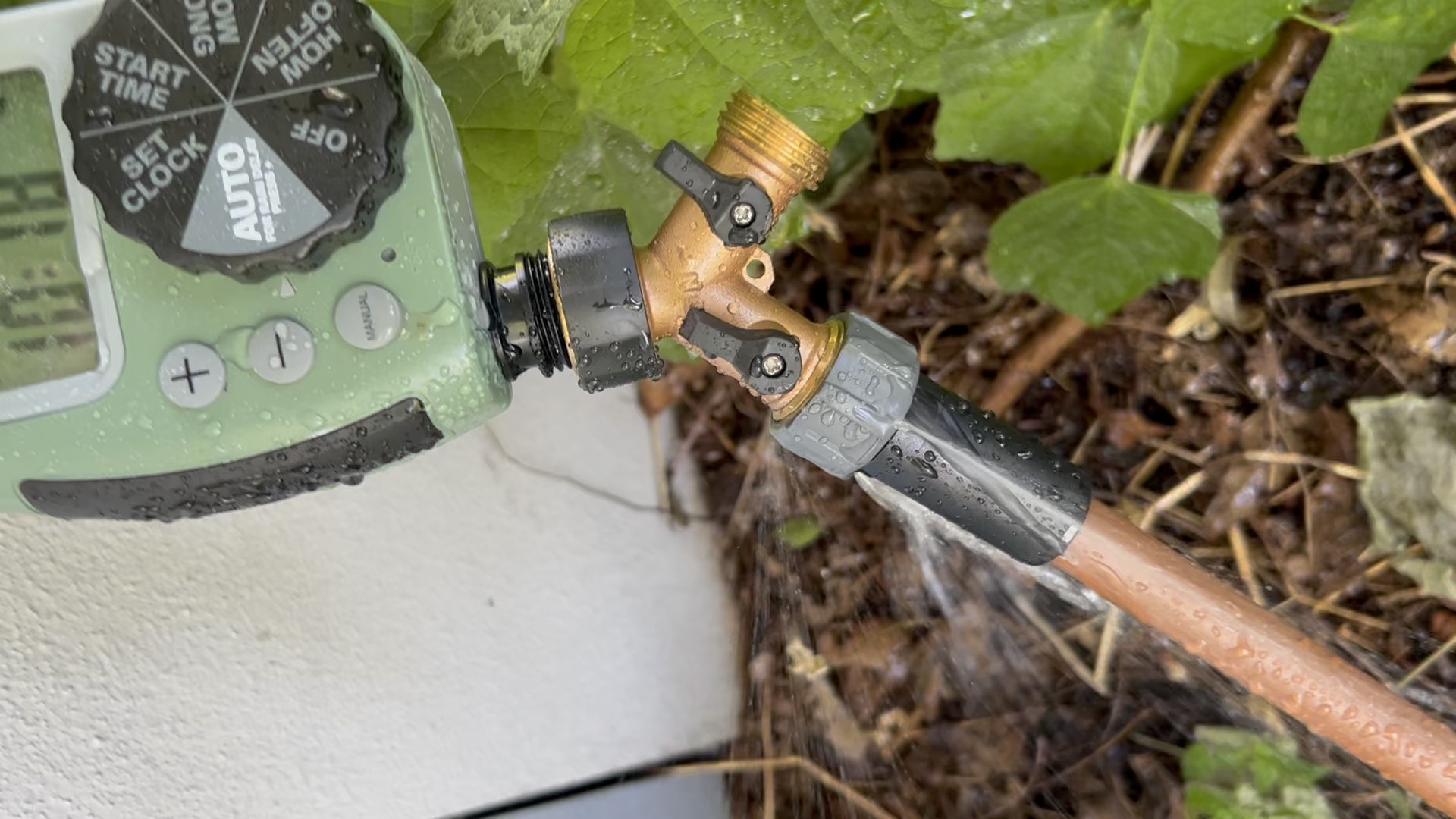
No matter what I tried, could not stop this spigot from spraying. –Photo by Monika Maeckle
Given the prescribed high maintenance and hours spent on multiple trips to Home Depot to purchase various adapters, pressurizers, rings and other extras, I decided that drip irrigation is not a good match for my yard, except perhaps in the isolated tomato garden. The choice came down to hose dragging or high maintenance. For now, I’ll enjoy the single tomato patch in my yard and drag my hose around the rest.
TOP PHOTO: Unirrigated tomatoes grew stunted. I removed them green, let them ripen on the counter and made tomato jam. –Photo by Monika Maeckle
Related posts:
- Finally! San Antonio gets its first native plant nursery, the Nectar Bar
- How to plan a successful butterfly garden
- Mostly native butterfly garden outperforms lawn every time
- A year in the life of an urban butterfly garden
- Downtown River walk plot converts to pollinator garden, creature haven
- Converting your Lawn to a Butterfly Garden
- San Antonio becomes first National Wildlife Federation Monarch Champion city
- Tropical Milkweed: To Plant it or Not is Not a Simple Question
Like what you’re reading? Don’t miss a single post from the Texas Butterfly Ranch. Sign up for email delivery, like us on Facebook, or follow us on Twitter, @monikam.

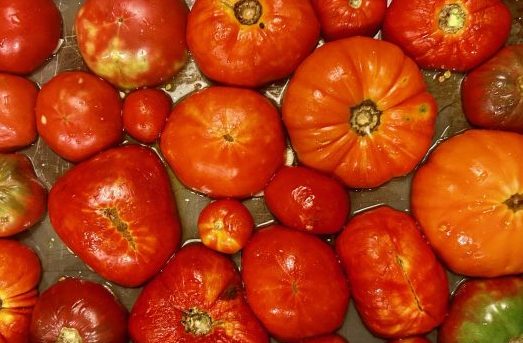
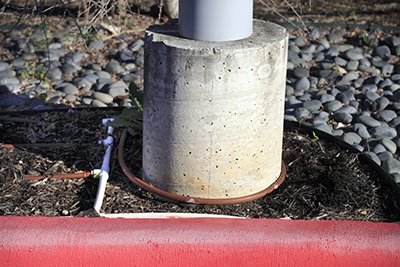
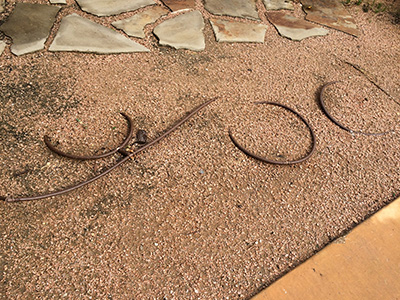
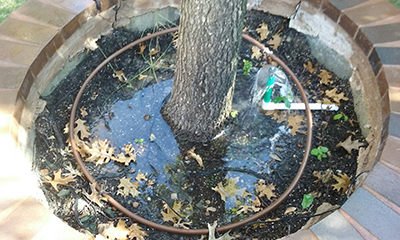

Thanks for the honest assessment. I’m a Texas Master Gardener; love to research and write. I still hand water. As per IPM guidelines, this enables me to slow down and observe nascent issues to resolve using IPM least-toxic protocols. Every year, I ponder drip, and may still install for vegetable beds if I can get some good coaching. However, if it ends up needing high maintenance every year, I may uninstall! BTW, we’re having a whole hose filter and descaler installed next week, so I’m curious to see its effect on watering gear, since the main outdoor hose bib will be part of the new system.
Oops, “whole house, not whole hose.”
Hi Howard, I am a garden lover too. Curious to know more about the whole house filter and descaler. Which brand? Are you doing it yourself? Thank you.
Good luck! I agree that dragging the hose around forces you to see what’s going on in a way you wouldn’t if you had a sprinkler set on automatic. Thanks for reading and writing. –MM
Thank you for your honest assessment! I will continue to drag my hose!
Thanks for the advice. I am experimenting with hollas and other underground reservoirs, but there are still a lot of kinks to work out. There’s a reason that this is not traditional farmland!
Thank you for the assessment. I have drip irrigation system and love everything but the timer. I think the last freeze did damage to it..